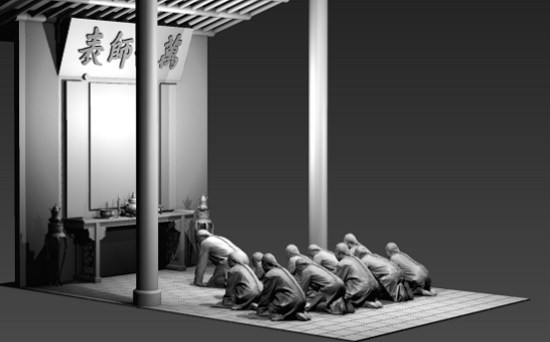Chinese 3D printer and scanner manufacturer Shining 3D, well-known for its EinStart 3D printers, EinScan software, and 3D scanners, began an ambitious art preservation initiative last year, asking people to 3D scan museum art and artifacts to create an online database of art and other historically significant items.
Recently, the company heard from Professor Nan Yu, with the Guangzhou Academy of Fine Arts, who used Shining 3D’s technology to, as the company put it, convey “the Chinese traditional culture of respecting teachers” in some very fascinating artwork.
Shining 3D’s Yuan Ruan told 3DPrint.com, “We recently received a very artistic case study of applying 3D scanning and 3D printing technologies into miniature artwork creation.”
Nan Yu said in the case study, “The combination of art and 3D technology can make the abstract history representational, allowing more public to relive history, experience the traditional virtual of respecting teachers, and memorizing the historical people and events.”
The artistic process for the project began with the concept design, as Nan Yu drafted out the five historically accurate parts of the appointment scene with the help of ancient records. The five separate appointment scenes are as follows:
- The next spring, Tso Tsung-Tang arrived at the academy and joined the banquet, together with the magistrate, the two instructors, the disciplinarian, and the chief.
- The chief of the academy led students in a salute to both Confucius and the new principal.
- After school had started, the chief of the academy invited the new principal, the magistrate, and both instructors for a drink.
- After a few days, Tso Tsung-Tang was invited to the Xingxian Hall for a banquet in “a highly respectful manner.”
Once the design for the overall concept was completed, several team members then put on costumes and posed in the proper positions, as other members used Shining 3D’s handheld EinScan Pro 3D scanner to scan the life-size characters.

Then, Nan Yu and the team modified the 3D data collected by the EinScan Pro, and created the architecture for the five scenes using 3D data modeling. In addition, the team members combined all of the scanned characters into the proper scene.
This case study, and the resulting 3D scanned and printed miniature scene, is just one more example of 3D printing technology bringing history to life.
Let us know your thoughts on this and other 3D printing topics at 3DPrintBoard.com or share in the Facebook comments below.
[Images provided by Shining 3D]
